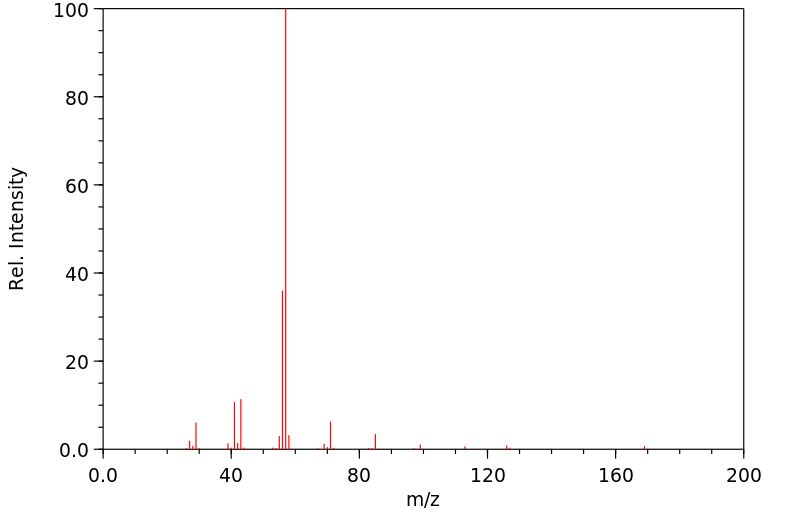2,2-二甲基十一烷 | 17312-64-0
中文名称
2,2-二甲基十一烷
中文别名
——
英文名称
2,2-dimethylundecane
英文别名
2,2-dimethyl-undecane;2,2-Dimethyl-undecan;2,2-Dimethylundecan;neotridecane
CAS
17312-64-0
化学式
C13H28
mdl
——
分子量
184.365
InChiKey
QDKSGHXRHXVMPF-UHFFFAOYSA-N
BEILSTEIN
——
EINECS
——
-
物化性质
-
计算性质
-
ADMET
-
安全信息
-
SDS
-
制备方法与用途
-
上下游信息
-
文献信息
-
表征谱图
-
同类化合物
-
相关功能分类
-
相关结构分类
物化性质
-
熔点:-28.13°C (estimate)
-
沸点:221°C
-
密度:0.7485
-
保留指数:1218;1215;1228
计算性质
-
辛醇/水分配系数(LogP):6.8
-
重原子数:13
-
可旋转键数:8
-
环数:0.0
-
sp3杂化的碳原子比例:1.0
-
拓扑面积:0
-
氢给体数:0
-
氢受体数:0
安全信息
-
海关编码:2901100000
SDS
反应信息
-
作为产物:描述:参考文献:名称:有机铜化学的一些不寻常方面:有机铜酸锂与一些新戊基对甲苯磺酸酯的反应摘要:二苯基铜锂和二甲基铜锂与相同的伯新戊基甲苯磺酸酯反应不同。几种仲新戊基甲苯磺酸酯与有机铜锂试剂反应,通过协同的1,2-脱氢磺化反应生成烯烃。如果无法进行抗消除,则会发生骨骼重排。DOI:10.1016/s0022-328x(00)92356-8
文献信息
-
Copper-Catalyzed Regioselective Hydroalkylation of 1,3-Dienes with Alkyl Fluorides and Grignard Reagents作者:Takanori Iwasaki、Ryohei Shimizu、Reiko Imanishi、Hitoshi Kuniyasu、Nobuaki KambeDOI:10.1002/anie.201503288日期:2015.8.3Copper complexes generated in situ from CuCl2, alkyl Grignard reagents, and 1,3‐dienes play important roles as catalytic active species for the 1,2‐hydroalkylation of 1,3‐dienes by alkyl fluorides through CF bond cleavage. The alkyl group is introduced to an internal carbon atom of the 1,3‐diene regioselectively, thus giving rise to the branched terminal alkene product.
-
Cu-catalyzed regioselective carbomagnesiation of dienes and enynes with sec- and tert-alkyl Grignard reagents
-
Novel method for generation of secondary organozinc reagent: Application to tandem carbon-carbon bond formation reaction of 1,1-dibromoalkane作者:Toshiro Harada、Yasuo Kotani、Takeshi Katsuhira、Akira OkuDOI:10.1016/s0040-4039(00)74275-4日期:1991.3Reaction of 1,1-dibromoalkane (R1CHBr2) with trialkylzincate ((R2)3ZnLi) followed by a palladium catalyzed coupling reaction of the resulting secondary organozinc reagent (R1CH(R2)ZnL) with various electrophiles (El-X) afforded R1CH(R2)El.
-
Copper-Catalyzed Alkyl–Alkyl Cross-Coupling Reactions Using Hydrocarbon Additives: Efficiency of Catalyst and Roles of Additives作者:Takanori Iwasaki、Reiko Imanishi、Ryohei Shimizu、Hitoshi Kuniyasu、Jun Terao、Nobuaki KambeDOI:10.1021/jo501006u日期:2014.9.19Cross-coupling of alkyl halides with alkyl Grignard reagents proceeds with extremely high TONs of up to 1230000 using a Cu/unsaturated hydrocarbon catalytic system. Alkyl fluorides, chlorides, bromides, and tosylates are all suitable electrophiles, and a TOF as high as 31200 h–1 was attained using an alkyl iodide. Side reactions of this catalytic system, i.e., reduction, dehydrohalogenation (elimination)使用铜/不饱和烃催化系统,烷基卤化物与烷基格氏试剂的交叉偶联可产生高达1230000的极高TON。烷基氟化物,氯化物,溴化物和甲苯磺酸盐都是合适的亲电子试剂,TOF高达31200 h –1使用烷基碘可以达到目的。在没有添加剂的情况下,该催化体系的副反应即还原,脱卤化氢(消除)和卤代烷的均偶联。看来该反应涉及烷基铜中间体的β-氢消除,从而产生烯烃和Cu-H物种,并且该过程既触发副反应又触发Cu催化剂的降解。形成的Cu–H可能促进歧化反应,从而促进烷基卤化物的还原,从而生成烷烃和Cu–X或Cu(0)的生成,这种歧化可以氧化添加到烷基卤化物中以产生烯烃,在某些情况下还可以是均偶联产物。1,3-丁二烯和苯丙炔等不饱和烃类添加剂通过抑制β-氢的消除在实现高效交叉偶联中起着重要作用,
-
Copper-Catalyzed Cross-Coupling Reaction of Grignard Reagents with Primary-Alkyl Halides: Remarkable Effect of 1-Phenylpropyne作者:Jun Terao、Hirohisa Todo、Shameem Ara Begum、Hitoshi Kuniyasu、Nobuaki KambeDOI:10.1002/anie.200603451日期:2007.3.12
表征谱图
-
氢谱1HNMR
-
质谱MS
-
碳谱13CNMR
-
红外IR
-
拉曼Raman
-
峰位数据
-
峰位匹配
-
表征信息
同类化合物
顺式-1-乙基-3-甲基环己烷
顺式-1-乙基-2-甲基环丙烷
顺式-1,3-二甲基环庚烷
顺式-1,2-二甲基环丙烷
顺式-1,2-二乙基环戊烷
顺式-1,2-二(1-甲基乙基)环丙烷
顺式-1,2-二(1-甲基乙基)环丙烷
顺式,反式,反式-1,2,4-三甲基环己烷
Copper, ethyl-
辛烷-d18
辛基环戊烷
辛基环丙烷
联苯肼酯
联环戊基
羰基双(环茂二烯基)钛
矿油精
癸烷,2,8-二甲基-
癸烷
decyl radical
癸基环戊烷
異十八烷
甲烷-d3
甲烷-d2
甲烷-d1
甲烷-D4
甲烷-3H
甲烷-13C,d4
甲烷-13C
甲烷
甲基自由基
甲基环辛烷
甲基环癸烷
甲基环戊烷
甲基环己烷-Me-d3
甲基环己烷
甲基环十一烷
甲基环丙烷
甲基环丁烷.
甲基丙烷-2-d
环辛烷-D16
环辛烷
环癸烷
环戊烷-D9
环戊烷-D10
环戊烷-13C1
环戊烷,三(2-辛基十二基)-
环戊烷
环戊基甲基自由基
环戊基环庚烷
环戊基环己烷







